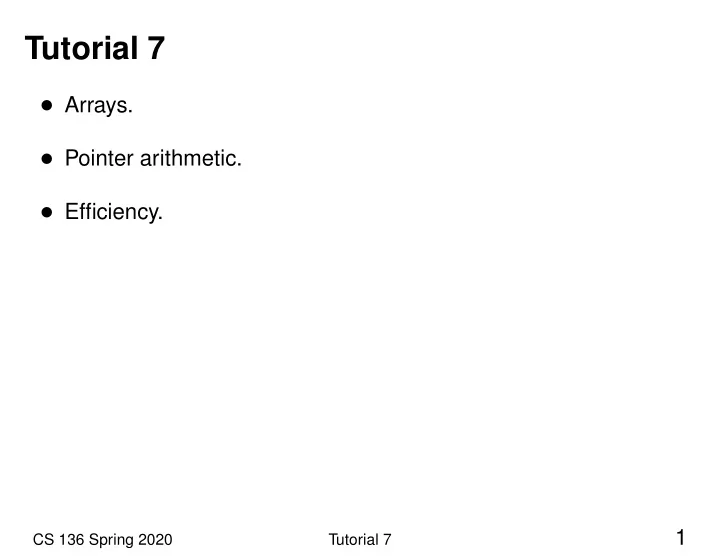

Tutorial 7 • Arrays. • Pointer arithmetic. • Efficiency. 1 CS 136 Spring 2020 Tutorial 7
Arrays They can be used to store a fixed number of elements of the same type . Example of array syntax: int my_array[3] = { 1, 2, 3 }; int x = my_array[0]; // x = 1 2 CS 136 Spring 2020 Tutorial 7
Array Initialization There are several ways to define an array: int a[3]; // array is not initialized, but it's defined int b[3] = { 1, 2, 3 }; // array is initialized int d[3] = {0}; // array of length 3, filled with zeros int e[8] = { 7, 4, 1 }; // {7, 4, 1, 0, 0, 0, 0, 0} 3 CS 136 Spring 2020 Tutorial 7
Array Exercise // reverse_array(arr, len) reverses the contents of arr // requires: arr is an array with length (at least) len // effects: modifies arr void reverse_array(int arr[], int len); 4 CS 136 Spring 2020 Tutorial 7
Pointer Arithmetic Certain arithmetic operations can be performed on pointers. An integer can be added or subtracted to a pointer, and pointers of the same type can be subtracted from one another. int a[10]; int *p = a; // a is a pointer to first element int *q = &a[9]; // address of 10th element q = a + 9; // equivalent a[2] = q - p; // set the value of 3rd element as 9 q = p + 1; // now q == &a[1] Addition of pointers is not allowed. 5 CS 136 Spring 2020 Tutorial 7
Array Exercise 2 Write Reverse again, now using pointer arithmetic (hint, this code will be essentially identical to reverse) // reverse_array(arr, len) reverses the contents of arr // requires: arr is an array with length (at least) len // effects: modifies arr void reverse_array(int *arr, int len); The syntax a[i] is shorthand for the equivalent expression *(a+i) . 6 CS 136 Spring 2020 Tutorial 7
Efficiency • When looking at a function, it is often useful to understand its running time. • To do this, we compute the running time as a function of the input size, and use Big O notation to simplify the computation. In this course, you will see the following running times: O (1) O (log n ) O ( n ) O ( n log n ) O ( n 2 ) O ( n 3 ) O (2 n ) 7 CS 136 Spring 2020 Tutorial 7
Recursive Functions Recall the steps for a recursive funtion: 1. Identify the order of the function excluding any recursion 2. Determine the size of the input for the next recursive call(s) 3. Write the full recurrence relation (combine step 1 & 2) 4. Look up the closed-form solution in a table 8 CS 136 Spring 2020 Tutorial 7
Recurrence Relations T ( n ) = O (1) + T ( n − k 1 ) = O ( n ) = O ( n 2 ) T ( n ) = O ( n ) + T ( n − k 1 ) T ( n ) = O ( n 2 ) + T ( n − k 1 ) = O ( n 3 ) T ( n ) = O (1) + T ( n k 2 ) = O (log n ) T ( n ) = O (1) + k 2 · T ( n k 2 ) = O ( n ) T ( n ) = O ( n ) + k 2 · T ( n k 2 ) = O ( n log n ) = O (2 n ) T ( n ) = O (1) + T ( n − k 1 ) + T ( n − k ′ 1 ) where k 1 , k ′ 1 ≥ 1 and k 2 > 1 9 CS 136 Spring 2020 Tutorial 7
Exercise: Identifying Complexity of the Factorial Function What is the running time of the following function? // requires: n >= 0 int fact(int n) { if (n == 0) { return 1; } else { return (n * (fact(n - 1))); } } 10 CS 136 Spring 2020 Tutorial 7
Exercise: Complexity Calculation Consider an array of n integers. Suppose you want to know whether m particular integers exist in this array. What is the time complexity if you sort the array using merge sort and search the array m times using binary search ? 11 CS 136 Spring 2020 Tutorial 7
Exercise: Sort and Search Write the following C program using merge_sort.h and bsearch.h: 1. It reads integers until it encounters 0 and puts them in an array. 2. Afterwards, it reads more integers until EOF , and prints "yes" or "no" depending on whether they are in the array. You must use the merge sort module to sort the array, and use the binary search module to search the array. 12 CS 136 Spring 2020 Tutorial 7
Recommend
More recommend